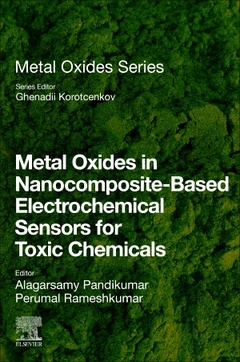Description
Metal Oxides in Nanocomposite-Based Electrochemical Sensors for Toxic Chemicals
Metal Oxides Series
Coordinators: Pandikumar A., Rameshkumar Perumal
Language: English
Subjects for Metal Oxides in Nanocomposite-Based Electrochemical...:
Keywords
Biosensors; Boron nitride; Carbon nanotubes; Chemical warfare reagents; Composite; Conducting polymer; Detection techniques; Electroanalysis; Electrocatalysis; Electrochemical sensor; Electrochemical sensors; Electrochemical; Endocrine disrupting chemicals; Environmental pollutants; Fluorescence sensors; Graphene; Heavy metal ion detection; Heavy metals; Metal oxide nanoparticles; Metal oxide; Metal oxide-graphitic carbon nitride; Metal oxides; Metal–organic frameworks; Modified electrode; MOF-MOx nanocomposites; Nanocomposite; Nanocomposites; Nanostructures; Nerve agents; Pesticides and disinfectants; Pesticides; Phenolic compounds; Porous carbon; Sensors; Toxic chemical; Toxic chemicals; Volatile organic compounds
372 p. · 15x22.8 cm · Paperback
Description
/li>Contents
/li>Biography
/li>Comment
/li>
Metal oxide nanomaterials exhibit interesting electrical and photochemical properties because of their size, stability, and high surface area that render them as great choices in fabricating alternative electrode materials for electrochemical energy storage and sensor applications. The hybridization of metal oxides with other materials lead to the improvement in electrical conductivity, stability, and electron transfer kinetics during the electrocatalytic reactions. These key factors result in greater sensitivity of the sensor materials towards the analyte molecules.
This book reviews the electrochemical determination of a variety of toxic chemical contaminants using metal oxide-based nanocomposite materials. Ultrasensitive and selective detection of toxic chemical contaminants is important and demanding, especially for monitoring and controlling environmental pollution. In recent years, metal oxide-based nanocomposite materials have shown high potential in the electrochemical detection of heavy metals, inorganic anions, phenolic compounds, pesticides, and chemical warfare reagents. Metal Oxides in Nanocomposite-Based Electrochemical Sensors for Toxic Chemicals comprehensively reviews this topic.
In addition to the instrumental simplicity, the electrochemical methods show the improved sensor performance through the synergetic effect of metal oxide and other electroactive nanomaterial present in the nanocomposite. Thus, detailed information on the electrochemical sensing of toxic chemical contaminants using metal oxide-based nanomaterials are discussed. The recent progress in developing electrochemical sensors using metal oxide-based nanocomposite materials and perspectives on future opportunities in sensor research and development are addressed in the book.
T. Ravindran Madhura, K.S. Shalini Devi and Ramasamy Ramaraj
2. Metal oxide-modi?ed electrochemical sensors for toxic chemicals
Venkata Surendra Tammineni, Chandra Sekhar Espenti, Sankararao Mutyala and Saravana Vadivu Arunachalam
3. Binary metal oxide-modi?ed electrochemical sensors for toxic chemicals
Nurul Izrini Ikhsan and Perumal Rameshkumar
4. Metal oxide-metal nanocomposite-modi?ed electrochemical sensors for toxic chemicals
K. Koteshwara Reddy, K. Yugender Goud, M. Satyanarayana, Shekher Kummari, V. Sunil Kumar, Harshad Bandal, Tippabattini Jayaramudu, Radha Devi Pyarasani, Hern Kim, John Amalraj and K. Vengatajalabathy Gobi
5. Metal oxide-graphene nanocomposite modi?ed electrochemical sensors for toxic chemicals
K. Theyagarajan, Kathavarayan Thenmozhi and Sellappan Senthilkumar
6. Metal oxide-carbon nanocomposite-modi?ed electrochemical sensors for toxic chemicals
Pitchaimani Veerakumar, Arumugam Sangili, Shaktivel Manavalan and King-Chuen Lin
7. Metal oxide-polymer nanocomposite-modi?ed electrochemical sensors for toxic chemicals
S. Radhakrishnan
8. Metal oxide-carbon nanotubes nanocomposite-modi?ed electrochemical sensors for toxic chemicals
Piyush Kumar Sonkar and Vellaichamy Ganesan
9. Metal oxide-graphitic carbon nitride nanocomposite-modi?ed electrochemical sensors for toxic chemicals
Vellaichamy Balakumar and Ramalingam Manivannan
10. Electrochemical sensors based on metal oxide-boron nitride nanocomposites in the detection of biomolecules and toxic chemicals
Elsa M. Materon, Nirav Joshi, Flavio M. Shimizu, Ronaldo C. Faria and Osvaldo N. Oliveira Jr.
11. Metal oxide-metaleorganic framework nanocomposite-modi?ed electrochemical sensors for toxic chemicals
N.S.K. Gowthaman, P. Arul, H.N. Lim and S. Abraham John
Dr. Perumal Rameshkumar is currently working as an Assistant Professor of Chemistry at Kalasalingam Academy of Research and Education, India. He obtained his M.Sc. (chemistry) (2009) from Madurai Kamaraj University. He joined as Junior Research Fellow (2010) at the same University and subsequently promoted as Senior Research Fellow (2012). His doctoral thesis focused on ‘polymer encapsulated metal nanoparticles for sensor and energy conversion applications’. He worked as Post-Doctoral Research Fellow (2014) at University of Malaya, Malaysia in the field of ‘graphene-inorganic nanocomposite materials for electrochemical sensor and energy conversion’. His current research interests include synthesis of functionalized nanomaterials, electrochemical sensors, energy-related electrocatalysis and photoelectrocatalysis. His research findings were documented in 34 peer reviewed journals including 01 review article. For his credit, he edited 02 books under Elsevier publications
- Introduces the fundamentals of electrochemical sensors and fabrication of metal oxide sensors of toxic chemicals
- Reviews binary, doped, metal oxide-metal, metal oxide-carbon, metal oxide-polymer, metal-boron nitride, metal oxide-clay, and metal oxide- MOF electrodes
- Systematically addresses the fabrication, synthesis, performance, mechanisms, detection limits, sensitivity, advantages and limitations and future perspectives of a wide range of metal oxide-based electrochemical sensors




